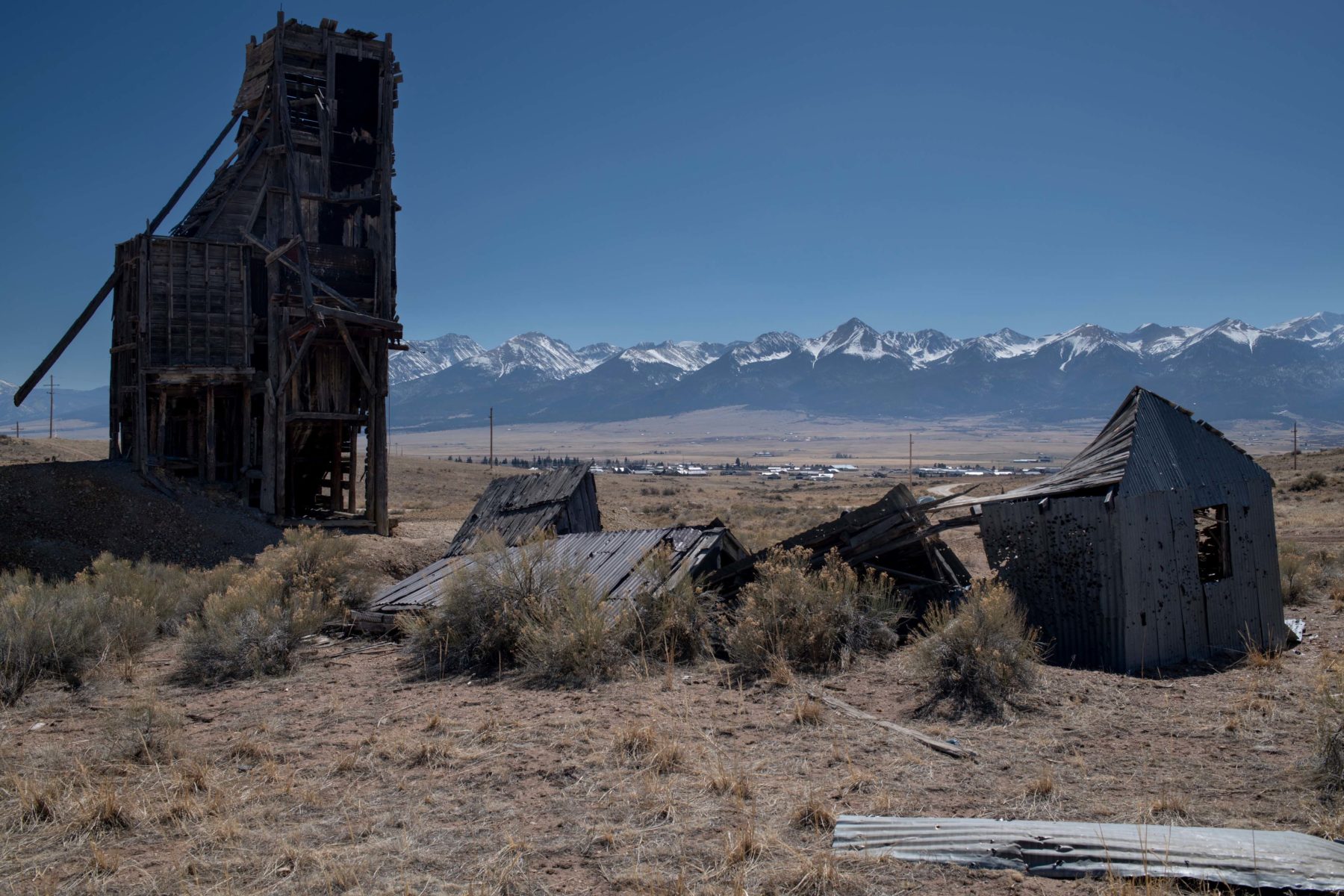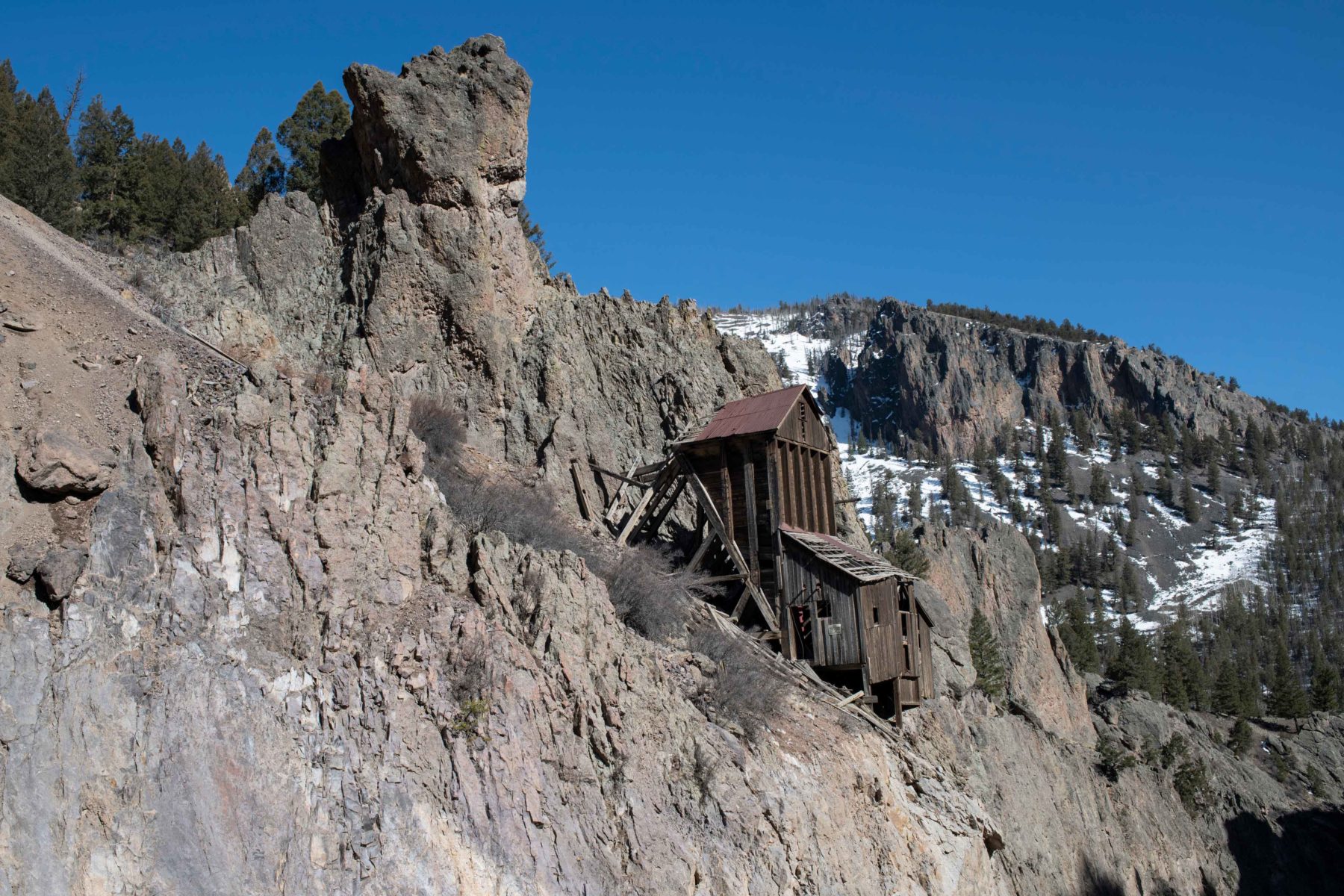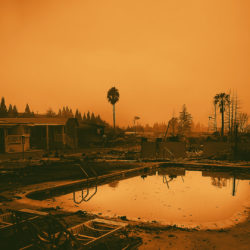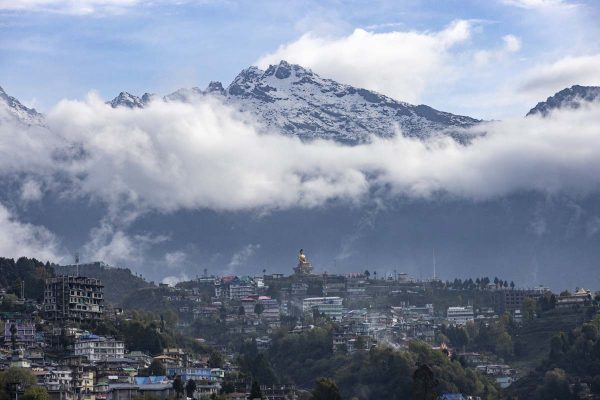
How 19th century silver mines could supercharge the US green energy economy
- By Sarah Scoles
- Photography by Rachel Woolf
- feature
It’s chilly inside the Creede Underground Mining Museum. For one thing, it’s winter. For another, the museum is located underground. That was the innovative idea of three local workers who decided to blast out the 10,000-square-foot space when the last of the town’s famous silver mines closed down. They wanted to show outsiders and younger generations alike what their lives, and the lives of their predecessors, were really like.
Heather Brophy, the facility’s director, is used to the museum’s cold: She spends all day down here. Sporting sophisticated pigtails and a nose ring on this winter day, the Creede native is 29, younger than one might expect for someone in her position. She is the keeper of information about an industry that — for all intents and purposes — died decades ago in Creede, Colorado. But growing up here, Brophy became fascinated by how mining had shaped her town.

Today, more than 30 years after the Bulldog Mountain Mine — the last stalwart — closed up shop, Creede’s long-gone industry might soon come alive and chisel a new story from its past.
Last year, the largest silver mining company in the United States, Hecla Mining, confirmed that it plans to dive back into the Bulldog mine, through its subsidiary, Rio Grande Silver. The mountain still holds plenty of metal, and the company is poised to extract it. Brophy wagers that as soon as the price of silver can guarantee a return on investment, Hecla will seek out its permits and head into production mode. “They will bring in crews,” said Brophy.
The American government just might be ready for that moment, too. Right now, the country is largely reliant on foreign silver sources. But soon, it’s going to need a lot more of the metal than it currently consumes: The shiny stuff is a key component in solar panels, electric cars, charging stations and 5G infrastructure, along with consumer electronics. The desire to increase mineral supplies in the country, while silver demand is increasing, means the U.S. could use more stateside silver than it currently mines.
The U.S. is keen on increasing the minerals the country sources domestically so that the availability of the metal won’t be determined by whether one country invades another, the general vagaries of international trade or supply chain delays.
Where to get it, though?
Sometimes, it turns out, the best places to start new mines are on the backs (or in the bellies) of old ones — in this case, that can mean in the heart of old silver boom towns, like Creede, that have gone bust. There, the ground is already excavated, data on what’s beneath already exists, and companies know for sure someone struck it rich in the past.
And so, that new work might happen in the shadows of the falling-down infrastructure of the past. Here in southern Colorado, where miners once pounded chisels — the risks to themselves and the earth largely unmitigated — a batch of hopefuls is trying to extract raw materials for the green energy economy while keeping a historically dirty business a whole lot cleaner than in the past.

Silver outwardly appears in things like jewelry, utensils or the coins your conspiratorial uncle hoards. But its physical properties make it useful, not just pretty. Silver reflects light better than any other metal and also better conducts heat and electricity. Plus, it’s antibacterial. It’s part of medical equipment and is an important ingredient in all kinds of electronics. It’s integrated into cars, cell phones, TVs. It’s in “everything that has an on-and-off switch,” said Michael DiRienzo, the executive director of the Silver Institute, an international nonprofit with members from across the silver mining industry.
And it’s going to become even more important as energy sources transition away from fossil fuels and toward more renewable energy: Silver is integral to solar panels’ workings, and it’s also a key to the zippy cars of the future. Last year, according to DiRienzo, the automotive industry used somewhere between 60 and 65 million ounces of the metal. “The number is just going to continue to grow as electric vehicles and, down the road, autonomous driving vehicles become more prevalent,” he said, going so far as to describe silver as a “decarbonization metal.”
According to a report from the International Energy Agency, an electric vehicle’s greenhouse emissions over its lifetime, including manufacturing and minerals, are half of those of a gasoline-powered car. There are some risks that come along with acquiring the minerals, like loss of habitat for animals and plants, significant water usage and potential for water contamination, air pollution and noise pollution. On balance, the risks of remaining dependent on fossil fuels, or not investing in the materials that clean energy requires, seem higher — for people and for the planet.
DiRienzo is bullish about the prospects. “The demand side in the last year was a new high,” he said. It shot up 17% from 2021. “The market was firing on all cylinders.”
Hecla, ensconced at the Bulldog Mine in Creede, agrees with the hopeful forecasting and its connection to decarbonization — or, at least, its documents agree. The parent company did not respond to my multiple requests for an interview.

In recent years, Hecla’s silver output has accounted for 40% of all silver mined in the U.S. And so, predictably, it’s hopeful about the current prospects. “We’re at an inflection point unlike anything we’ve seen in more than a century,” says a 2021 Hecla document called “Silver: The Story of Our Past, the Foundation of Our Future.” That inflection comes courtesy, the company claims, of the transition to clean energy.
The document may be company propaganda, but data from the U.S. Energy Information Administration backs up some of its key assertions. To keep up with solar panel production alone, the world will need 500 million ounces of silver by 2050. Meanwhile, American domestic silver production has stagnated. Just four mines in the U.S. produced silver as their primary output last year. The rest of the approximately 32 million ounces came from mines that primarily dig for lead, zinc, copper or gold. To be part of the potential impending boom, those numbers will have to change.
But these aspirations can get complicated: If a company wants to open a mine on federal land, for instance, there’s a lot of paperwork and waiting involved.
“Starting a new mine is much more difficult now than it was a hundred years ago,” says Hecla’s report. “You can’t just dig a hole in the ground and start producing.”
In fact, according to DiRienzo, if you started the clock at zero when you found silver in the ground, “it would take you nearly 10 to 12 years before you finally get the permitting to go ahead.” Those permits are there for a reason, of course. “The process is to make sure everything's good,” he said. “You can’t just go in there and start destroying.”
Subscribe to our Authoritarian Tech newsletter
From biometrics to surveillance — when people in power abuse technology, the rest of us suffer. Written by Ellery Biddle.
But it can make things difficult for companies that won’t see any profit from their labor for many years. While what happens at any given site is different, and every state is different, the mining industry is in general subject to laws like the National Environmental Policy Act, which requires a detailed analysis of how a project on federal land will impact an area and its occupants. The Clean Air and Clean Water Acts deal with issues like dust and other particulate pollutants, along with stormwater runoff near mines and the disposal of water used in extractive operations.
Officially, the United States still operates on a legal framework for mining on federal lands that was written in 1872, but that could change. In 2022, the Biden administration released its principles for proposed mining reform, predicated on the idea that the U.S. needs to mine more of its own goods, create jobs and do so in a way that’s environmentally and socially responsible.
The “how” part of that plan includes making sure strict standards are in place, consulting with local tribes and communities, protecting places with sensitive ecosystems or Tribal Nations’ resources, recycling material that’s already been mined and processed and cleaning up the messes of extractions past.
Oh, and companies could have to pay royalties on their spoils, if they extract silver from land owned by the government, which is effectively taxpayers’ land. That money would go in part toward mitigating or preventing environmental and social impacts of mining, which today are still no small matter.
Mines take up space that might otherwise be used by communities, flora and fauna. They also produce more waste material than they do metal. Water near silver mining sites regularly gets contaminated. According to the Government Accountability Office, abandoned hardrock mines have “contributed to the contamination of 40% of the country’s rivers and 50% of all lakes.” Historically, people have also used mercury, a pretty toxic substance, as part of the silver extraction process.
Reforms to the regulatory system and the long timelines, when coupled with the call for more domestic mining, irk Michael Feinstein, the founder of a geologic exploration company called MineOro. Produce things within the country, the government demands. “But the next breath they tie the hands of any potential domestic production,” Feinstein said.

As the largest silver producer in the country, Hecla can untie its hands better than most. And with the company’s purchase of the rights to 21 square miles of land in the Creede Mining District, Hecla has been working to make Bulldog’s old infrastructure accessible again. The company planned an exploration campaign for 2022 to figure out what metal was left in the mountain, where it was and how best to access it.
Brophy, the Creede museum director, details these efforts as she bustles about the caved, rocky interior of the museum, sending visitors — who’ve braved the incoming, days-long winter storm — out on the audio tour. Headphones on, they’ll wind their way through a U-shaped tunnel of exhibits featuring mannequins posing as miners throughout the decades. The first little group shows how Creede’s 19th century miners, seeking silver, used hammers and iron drills to hand-pound into the rock. Later, they transitioned to using hydraulic drills, affectionately known as “Widow Makers,” named for the silica dust they kicked up that got sucked right into the miners’ lungs. Then, farther into the tunnel, the inanimate miners show how life — and pulling material out of the planet — became easier and safer, as, for instance, mechanized equipment required less backbreaking labor. The industry also figured out that if you wet the material before drilling into it, you could reduce dust. From there, ventilation improved, and cave-ins became less frequent.
“There's a ton of history here,” said Brophy, a space heater blowing air toward her desk chair. “But that's pretty much all there is right now.”



Randy McClure, the current site and safety manager for Rio Grande Silver, is a third-generation Creede resident. His grandfather homesteaded near the town in the late 1800s, and McClure himself started working in the mines when he was 18. If the industry bounces back, it wouldn’t just change the state of the mine but also the state of the town.
“A return of mining to Creede would bring back a solid year-around economy, families with kids to fill the school, and the characters that make a mining town great,” he said.
As mining declined and then ceased, Creede’s population shrank — today, there are just 700 residents. The town shifted to arts, theater and outdoor tourism to survive, meaning it is now home to a mix of people who’ve been around since the mining days and those who were attracted to its new offerings. The different groups are learning to coexist, Brophy says. If the Bulldog reopens, they may have to find a new equilibrium.
“Mining is our roots,” Brophy said. “It's what we came from. Without mining, this place never would have existed.”
Anyone who likes Creede’s repertory theater and art, in other words, really has the town’s dirty, dangerous business of the past to thank. And they may have a modern version to thank for the town’s future.

Hecla’s re-exploration of this former boom site seems to mirror other efforts in the American West. Idaho’s aptly named Silver Valley is home to mines owned by Hecla and by a company called Sunshine Silver Mining and Refining that has gobbled up tens of thousands acres of mineral rights in the area. One patch includes the Sunshine Silver Mine that began in the 1800s and closed in 2001. In 1972, the mine was the site of one of the worst mining disasters in history, when a fire broke out underground. Sunshine Silver declined to comment for this story, stating that while it was exploring, it wasn’t actively mining.
In the small, adjacent towns of Silver Cliff and Westcliffe, Colorado, meanwhile, a Canadian company called Viscount Mining has been digging around old mining areas. These locales, along with nearby ghost towns, once hosted one of the biggest silver booms in the state.
Silver Cliff was the third largest Colorado city in the late 1800s, as prospectors and miners flocked to the high-altitude valley, flanked by two mountain ranges. In the 2020 census, it had just around 600 residents. Westcliffe had 435.
The holes and mine-waste — loose piles of rocky leftovers (called tailings) that lay fan-shaped over mountainsides — that this silver boom left behind remain, easily visible on a drive through town. Both also appear in the deep woods on hikes. Today, the downtown area shared by the two towns is a bit bigger than Creede’s, and it also has live theater, art galleries and many burger joints for hungry climbers who probably failed to get to the top of the 14,000-foot peaks that point to the sky above town.
Like Creede, Silver Cliff hasn’t made much silver since those very early days. But that past is not so distant: When the dirt roads in town get graded, you can find miners’ abandoned tin cans or the occasional century-plus-old belt buckle. Decrepit wooden structures loom around the landscape, alongside badlanded tailings piles, all begging for photographs — and, apparently, begging at least one company to plumb their depths.
Viscount, which did not respond to multiple requests for comment, has invested in two silver exploration projects, both of which sit on 19th century boom spots. The company’s website has a gallery of images, showing two wooden structures left to decay and collapse, along with an old claim boundary, carved into rock, from the initial discoverer. It looks like a tombstone.
These modern explorers, currently drilling for samples, have at their fingertips tools that were unimaginable back during Silver Cliff’s previous boom, like surveying instruments that can provide a picture of what lies 1,500 meters (nearly 5,000 feet) or more underneath the shoes of the surveyor.
With this data in hand, the company suggests its Silver Cliff property could be home to one of the largest silver deposits in the entire U.S.
If that’s the case, life in Silver Cliff, like life in Creede, could someday shift, looping back on itself like a time machine.

A new-old industry in towns like these could be an ultimate good: more jobs, more money, more renown. And getting silver from towns like these could, counterintuitively, be an ultimate good for the environment. If the silver has to come from somewhere, it might as well be a place with a number of environmental restrictions, controls and regulations — along with the current administration’s proposal to reform and improve policies that are already on the books.
For its part, Hecla claims to have the lowest carbon emissions in the industry per dollar of revenue. Most of the electricity it uses comes from hydropower, and it sucks out less water to produce an ounce of silver than the average person uses in a day. Mining in general is notorious for its water usage, accounting for 1% of all water usage in the United States. Hecla also generally backfills areas it mines — taking the waste that, in the past, might just have ended up stranded on a hillside, combining it with cement and filling up the empty, extracted places. That shore-up means that the land won’t collapse or be dotted by the abandoned pits that are so ubiquitous in the American West.
But Hecla has caused plenty of harm, too. In 2011, it paid $263 million to the federal government, the Coeur d’Alene tribe and the state of Idaho to settle a Superfund lawsuit about historical waste that its operations had discharged into the South Fork of the Coeur d’Alene River, causing harm to the water itself, fish and birds. In 2015, it paid $600,000 in fines after releasing heavy metals, in addition to other pollution, into the same river. Although no environmental fees have been levied against Hecla since then, the company has had more than a dozen workplace safety or health violations, for issues like using equipment beyond the capacity it was designed for or not correcting safety-relevant defects in machinery in a timely way.
Nevertheless, mining is safer and more friendly to the ground, water, animals and humans near its operations than it used to be.

Not everyone wants a mine in their backyard or as their employer. But as the final exhibit in the Creede Underground Mining Museum points out, it’s not so simple as yelling, “not in my backyard!”
If you like phones, and solar panels, and electric cars, the material that goes into them has to come from below someone’s backyard. “Since minerals exist randomly throughout the world, we do not always have the simple choice to mine or not to mine at home,” read the museum’s final panels.
But nor do people watching a potentially impending silver boom just have to sit back and let it happen, as it happens. Public information and engagement can make the industry better. It was agitation from the public, the museum’s signs point out, that helped usher in American environmental reforms that companies like Hecla and Viscount now have to abide by. Though companies in any industry can sometimes consider federal fines to be the cost of doing business, the Environmental Protection Agency can criminally prosecute, and jail, those who they can prove knowingly broke the rules.
For now, here in Creede, Hecla is waiting for the economics to tip in its favor, as they keep Bulldog’s underground infrastructure pumped free of the water that builds up underground and analyze how best to dig into the metal in the future.
Brophy is ready for the next chapter of her town’s complicated industry — a potential resurrection of the town as it used to be, mixed with the way it has become. A condition that might be more accurately described as reincarnation.
“Mining is our past,” said Brophy. “And we hope that it's our future.”
The story you just read is a small piece of a complex and an ever-changing storyline that Coda covers relentlessly and with singular focus. But we can’t do it without your help. Show your support for journalism that stays on the story by becoming a member today. Coda Story is a 501(c)3 U.S. non-profit. Your contribution to Coda Story is tax deductible.
The Big Idea
Shifting Borders
-

When your body becomes the border
feature Erica Hellerstein
-

India and China draw a line in the snow
feature Shougat Dasgupta
-

How an EU-funded agency is working to keep migrants from reaching Europe
feature Zach Campbell and Lorenzo D'Agostino
-

Turkey uses journalists to silence critics in exile
feature Frankie Vetch










